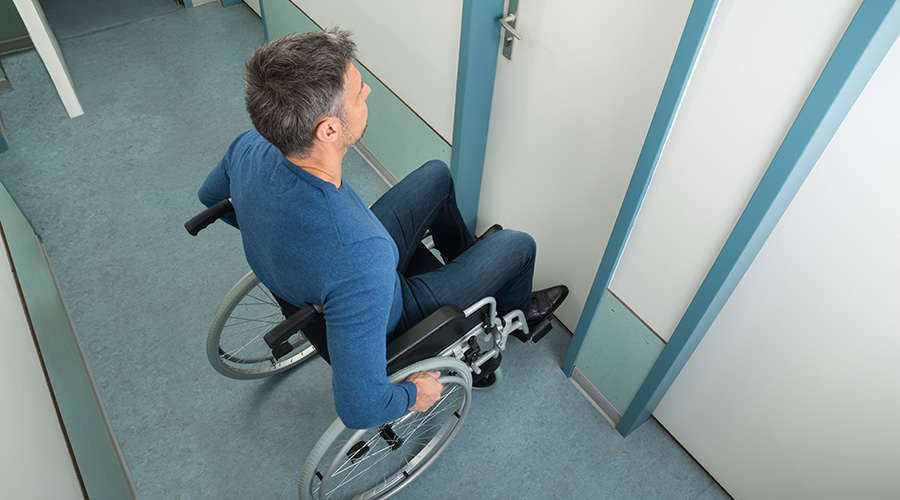Opportunities for Access
Carefully planned, renovations offer managers a chance to improve the accessibility of facilities
Building retrofits offer engineering and maintenance managers opportunities to upgrade the physical structure of both buildings and equipment. But with careful planning, managers also can take advantage of opportunities to increase access in facilities and avoid creating additional barriers.
Having a solid barrier-removal plan developed from accurate inspections and appropriate standards is important before beginning retrofit or renovation projects. A barrier-removal plan that is incorporated into an overall facility plan helps managers avoid overlooking cost-effective opportunities, decreases liability and provides an accessible environment.
Not having a comprehensive barrier-removal plan is the most common error for renovations or retrofits. In addition to having a comprehensive plan for facilities, the most common areas for errors in accessibility barrier removal that occur during such projects generally include restrooms, paths of travel, ramps, doors, signage and drinking fountains.
Restrooms
Restrooms are common areas for accessibility errors because of the many accessible features a restroom requires.
Soap dispensers, paper-towel dispensers, and mirrors often are mounted at improper heights. Planners often interpret the mounting height of 40 inches above the floor surface as the lowest part or bottom of the item, such as a paper-towel dispenser, instead of as the highest operable part or mechanism. Mirrors are frequently incorrectly mounted at 40 inches above the finished measuring from the frame, instead of the reflective edge of the mirror.
Clear floor space for a 60-inch turning radius is imperative to provide an accessible restroom. Often, 60 inches is provided during the actual design of a restroom, but during construction, a door is installed that encroaches into the 60-inch turning radius, making the restroom non-accessible.
Grab bars commonly are mounted at the incorrect heights, and incorrect length mirrors are used. When designing a larger restroom with six or more stalls, facilities often add an accessible stall, though they commonly overlook the 36-inch-wide ambulatory stalls used to accommodate people who use crutches, a cane or a walker.
Lavatories should be mounted with the compliant knee clearance of 29 inches, but careful and comprehensive planning will prevent problems by also providing 27 inches of knee clearance at a depth of 8 inches.
Finally, many facilities with accessible lavatories make the mistake of not wrapping pipes under sinks or counters. Sufficient wrapping helps protect visitors from contact with hot surfaces.
Paths of Travel
A goal of the Americans with Disabilities Act (ADA) is to give people with disabilities the same path of travel into and throughout a facility as individuals without disabilities. Path-of-travel problems usually occur when slopes are greater than 5 percent and cross-slopes are greater than 2 percent. If path-of-travel slopes are determined during planning, it offers sufficient time to design and install a ramp.
It is also important to remember that not everyone arrives at a facility by vehicle. Wheelchair users and pedestrians often must cross or use driveways to enter a facility. Facility planners must include an accessible route from the public right of way to the main entrance of the facility.
Often, paths of travel comply with ADA standards at the time of construction, but items such as display cases, pay telephones and drinking fountains that are installed after construction are placed directly in the path of travel and might be protruding objects.
Ramps
Careful ramp planning and design is essential for avoiding problems. A frequent error in ramp design is that planners use the maximum slope of 1:12, rather than designing to the smallest slope possible. Due to onsite adjustments, a ramp designed at the maximum slope is more likely to exceed the maximum slope and be non-compliant.
Another common problem with compliant ramps is the intermediate landing. On switch-back ramps or ramps that change directions more than 30 degrees, the intermediate landing must be 72 inches long. Without sufficient planning for an intermediate landing, a wheelchair user must climb a step incline too far without a level surface to rest and turn.
Also, handrails are required so a person using a mobility device can maintain balance. Typically overlooked is the requirement for 12-inch extensions beyond the top and bottom of the ramp.
Facilities also should provide edge protection to prevent a wheelchair user from falling off a sloping edge. Many inspections reveal that portable buildings typically use one standard ramp design. The design allows for a 60-inch top landing, which is sufficient. But installing metal handrails reduces the top landing, usually to 58 inches. Also, handrails on ramps usually are not continuous.
Doors
Many facilities use single-knob, thumb-latch or finger-pull doorknobs with insufficient clearance between the door and the hardware on an entrance door to an accessible room. Door hardware must not require tight pinching or twisting of the wrist to operate.
Door pressure is another common door problem. Adjusting exterior door pressure to a maximum of 81/2 pounds and interior doors to a maximum of 5 pounds at installation can prevent future problems.
Signage
A common error with signage involves improper installation or a lack of the required signage. Accessible entrances should display an international symbol of accessibility.
Room signage should be mounted at 60 inches above the floor surface on the latch side of the entrance door of an accessible room. Facilities also should install directional signage from the public right of way to the main entrance and other common use areas.
In keeping with the spirit and the requirements of ADA, it is important not to treat individuals with disabilities differently based on their disability. Accessible buildings are safer and more accessible to users. Building retrofits offer many opportunities to enhance compliance.
Selecting qualified ADA contractors also is important to make sure that planning is properly implemented and accessibility efforts are executed so that every aspect of removing barriers can be achieved the first time. Planning for accessibility using a barrier- removal plan with the correct state and federal standards avoids overlooked opportunities, saves money and provides compliant work to make a facility more accessible.
Related Topics:











